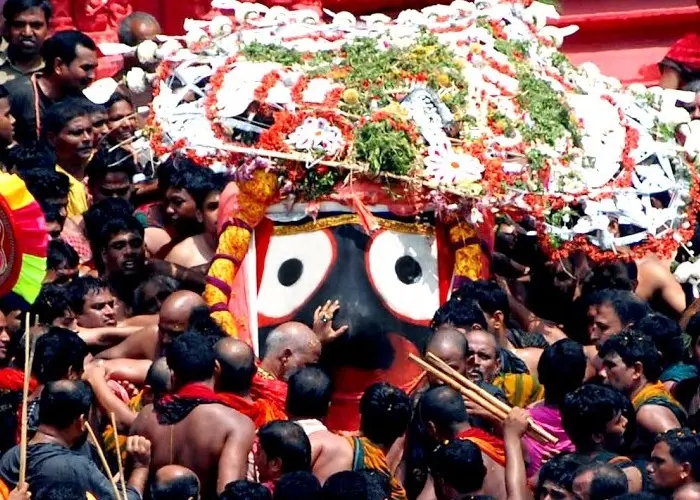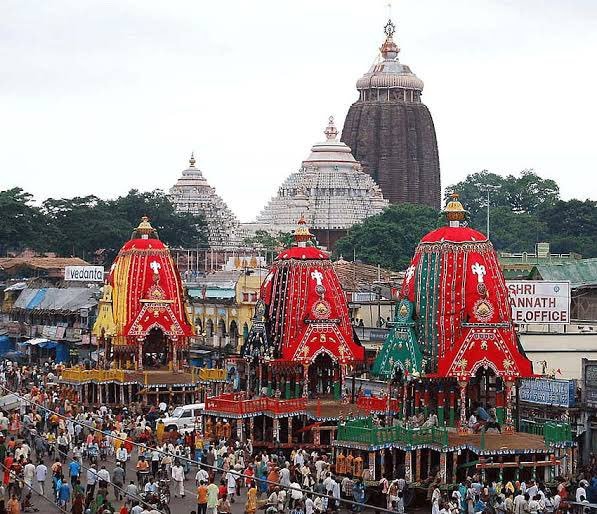To begin with, India, with its rich tapestry of spiritual traditions, is home to countless deities—but there’s something eternally powerful and universal about Lord Jagannath. Chanted with reverence across homes, temples, and streets is the simple yet soul-stirring phrase: “Jai Jagannath!”
Next, who really is Jagannath? What is Jagannath Dharma? Why do so many see Him as not just a god, but the God who embraces all?
Finally, this detailed blog walks you through the spiritual, historical, and socio-cultural journey of Jagannath Dharma, the grandeur of Jagannath Temple, and why the chant “Jai Jagannath” transcends time, religion, caste, and gender.The Heart of Odisha – Who Is Lord Jagannath?
Lord Jagannath—literally meaning “Lord of the Universe”—is not just the presiding deity of the Puri temple, but a unique form of Krishna/Vishnu who is worshipped in a tribal, tantric, Vaishnavite, and even Buddhist form. His famous wooden icon—along with siblings Balabhadra and Subhadra—doesn’t conform to typical Hindu idol styles.
As a result, this divine trinity stands as a symbol of universality, inclusivity, and compassion.
The Historical Roots of Jagannath Dharma
Origins in Puranas & Tribal Legends
- Jagannath finds mention in ancient texts like Skanda Purana, Padma Purana, Bamana Purana, and Sarala Mahabharata.
- Additionally, described as Purushottama—the Supreme Being—He was worshipped on the sea shores of Odra Desha (present-day Odisha).
- Furthermore, some believe He evolved from a tribal deity known as Jaganta or Jagun, worshipped by the Sabaras, a tribal community.
Temple Construction & Royal Devotion
- In the 10th century, King Yayati I of the Somavamshi dynasty built the early temple.
- Subsequently, Chodaganga Deva of the Ganga dynasty constructed the magnificent present-day Jagannath Temple in the 12th century, though he originally worshipped Shiva.
- Eventually, rulers like Anangabhimadeva and Kapilendra Deva called themselves Routa (deputy) of Jagannath and dedicated their rule to Him.
The Spiritual Philosophy of Jagannath Dharma
Dharma Rooted in Equality
- Indeed, Jagannath Dharma promotes equality—be it caste, class, or gender.
- Moreover, everyone shares Mahaprasad (the sacred food), regardless of caste.
- Furthermore, Balaram Das’s Laxmi Purana beautifully illustrates this inclusive spirit: when Goddess Lakshmi accepts the devotion of a low-caste woman, it teaches a moral lesson in the temple itself.
Symbolism of Rebirth – The Ritual of Nabakalebara
- Typically, priests ritually rebirth the idols every 12-19 years.
- Meanwhile, priests secretly transfer the Brahma Padartha, a mysterious life-element believed to be divine, from the old idols to the new.
- Thus, this sacred transition showcases impermanence and rebirth, blending Hindu rituals with tribal practices.
Jagannath Temple – A Sacred Architecture of Harmony
- Situated in Puri (Shrikshetra), the Jagannath Temple is not just a spiritual structure but a living embodiment of Jagannath Dharma.
- It features elements of Shaivism (Shiva temples nearby), Shaktism (Goddess Vimala), Buddhism (Buddha identified with Jagannath), and Vaishnavism.
- Chhera Pahanra during Rath Yatra, where the Gajapati King sweeps the chariots, symbolizes ultimate humility before the divine.

People Also Ask
1. What is Jagannath Dharma?
2. Why is Lord Jagannath made of wood?
3. How is Lord Jagannath different from Krishna?
4. What is the significance of sharing Mahaprasad?
5. What does "Jai Jagannath" mean?
Influence of Jagannath Dharma Beyond Odisha
-
Jayadeva, author of Gita Govinda, notably sang Lord Jagannath’s divine love stories.
-
Sri Chaitanya Mahaprabhu specifically saw Him as Krishna Himself and danced in ecstasy in Puri.
-
Furthermore, saints like Sarala Das and Jagannath Das connected Him to Buddha, symbolizing spiritual awakening.
Moreover, even British colonial officers noted how the Jagannath Temple oversaw multiple Shiva temples, showing its composite spiritual control.
Jagannath for Today’s World
- Egalitarianism: Indeed, in a world divided by class and race, Jagannath Dharma promotes oneness.
- Rebirth & Change: Moreover, Nabakalebara teaches us that change is sacred and necessary.
- Devotion over Identity: Truly, whether you’re a tribal, Vaishnav, Buddhist, or just a seeker—Jagannath accepts all.
